#eli amida
Text

Mom and Kids:D
This should be my "last" post before school starts… Time is a little tight, the color is not so good…(◐‿◑)
#cuphead parents#cuphead#cuphead oc#cuphead and mugman parents#eli amida#mugman#amida olit reint family
58 notes
·
View notes
Text
magma with @ask-cup-mug-parents

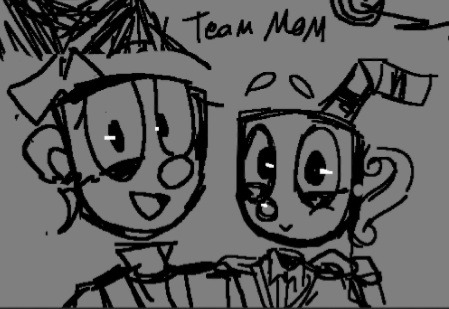
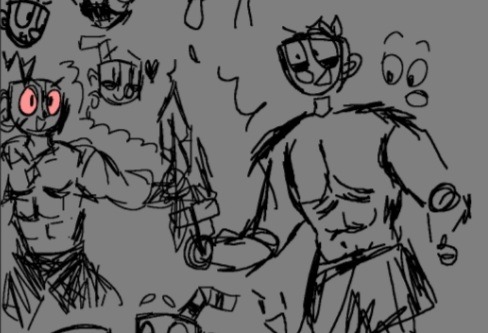

Eli and vickers belong to them
#cuphead parents#cuphead ocs#cuphead and mugman parents#thebloodofcalixanimiau#mysteriousinkwellislesau#Eli amida#Vickers Leant#vickersandeli#sir teacup#madammug
22 notes
·
View notes
Text

Wuhu_(:D)∠)_
Of course, the style idea comes from the Casino Cup
16 notes
·
View notes
Text
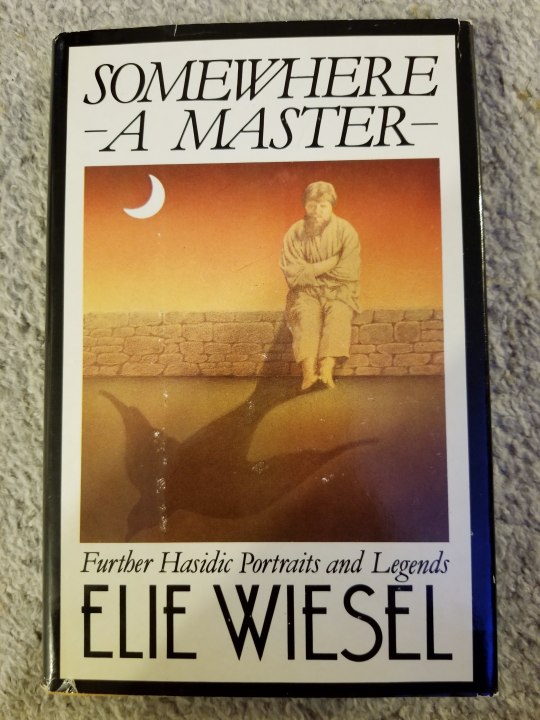
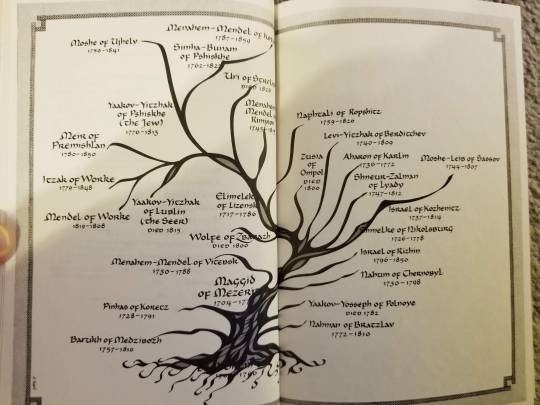
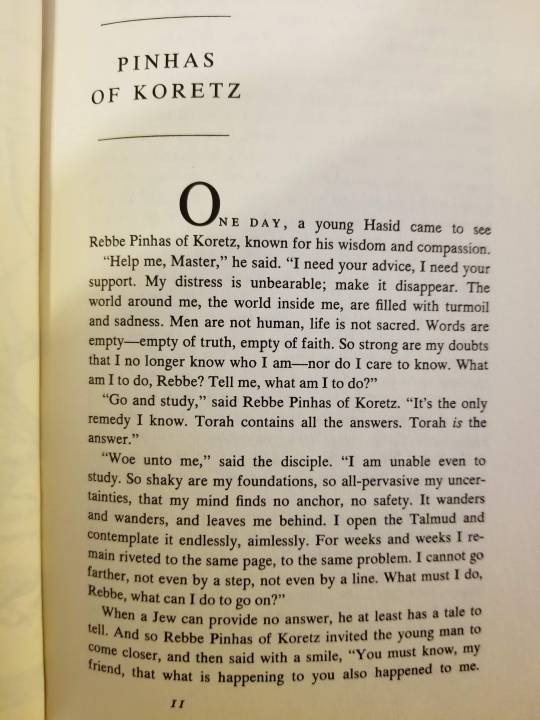

today i opened Elie Wiesel's second volume of portraits of 18th and 19th century Hasidic masters. and i came upon this story about Rebbe Pinhas of Koretz.
Wiesel's portraits continue to resonate through the years. and the wisdom they offer is more relevant now than ever.
as Wiesel says, "a good story in Hasidism is not about miracles, but about friendship and hope — the greatest miracles of all".
that's true of the Jewish community too. the Jewish community continues to be a place of friendship and hope in the face of darkness.
here is the full text of Wiesel's anecdote:
.
One day, a young Hasid came to see Rebbe Pinhas of Koretz, known for his wisdom and compassion.
“Help me, Master,” he said. “I need your advice, I need your support. My distress is unbearable; make it disappear. The world around me, the world inside me, are filled with turmoil and sadness. Men are not human, life is not sacred. Words are empty — empty of truth, empty of faith. So strong are my doubts that I no longer know who I am — nor do I care to know. What am I to do, Rebbe? Tell me, what am I to do?”
“Go and study,” said Rebbe Pinhas of Koretz. “It's the only remedy I know. Torah contains all answers. Torah is the answer.”
“Woe unto me,” said the disciple. “I am unable even to study. So shaky are my foundations, so all-pervasive my uncertainties, that my mind finds no anchor, no safety. It wanders and wanders, and leaves me behind. I open the Talmud and contemplate it endlessly, aimlessly. For weeks and weeks I remain riveted to the same page, to the same problem. I cannot go farther, not even by a step, not even by a line. What must I do, Rebbe, what can I do to go on?”
When a Jew can provide no answer, he at least has a tale to tell. And so Rebbe Pinhas of Koretz invited the young man to come closer, and then said with a smile, “You must know, my friend, what is happening to you also happened to me. When I was your age I stumbled over the same obstacles. I, too, was filled with questions and doubts. About man and his fate, creation and its meaning. I was struggling with so many dark forces that I could not advance; I was wallowing in doubt, locked in despair. I tried study, prayer, meditation. In vain. Penitence, silence, solitude. My doubts remained doubts. Worse: they became threats. Impossible to proceed, to project myself into the future. I simply could not go on. Then one day I learned that Rebbe Israel Baal Shem Tov would be coming to our town. Curiosity led me to the shtibl, where he was receiving his followers. I entered just as he was finishing the Amida prayer. He turned around and saw me, and I was convinced that he was seeing me, me and no one else. The intensity of his gaze overwhelmed me, and I felt less alone. And strangely, I was able to go home, open the Talmud, and plunge into my studies once more. You see,” said ready Pinhas of Koretz, “the questions remained questions. But I was able to go on.…”
What did Pinhas of Koretz try to teach his young visitor? One: Not to give up. Even if some questions are without answers, go on asking them. Two: Doubts are not necessarily destructive — provided they bring one to a Rebbe. Three: One must not think that one is alone and that one's tragedy is exclusively one's own; others have gone through the same sorrows and endured the same anguish. Four: One must know where to look, and to whom. Five: God is everywhere, even in pain, even in the search for faith. Six: A good story in Hasidism is not about miracles, but about friendship and hope — the greatest miracles of all.
#this was exactly what i needed to read today...#jewish history#jumblr#judaism#jewblr#jewish tradition#elie wiesel
82 notes
·
View notes
Text
1 And it was at that time that Abraham again took a wife in his old age, and her name was Keturah, from the land of Canaan.
2 And she bare unto him Zimran, Jokshan, Medan, Midian, Ishbak and Shuach, being six sons. And the children of Zimran were Abihen, Molich and Narim.
3 And the sons of Jokshan were Sheba and Dedan, and the sons of Medan were Amida, Joab, Gochi, Elisha and Nothach; and the sons of Midian were Ephah, Epher, Chanoch, Abida and Eldaah.
4 And the sons of Ishbak were Makiro, Beyodua and Tator.
5 And the sons of Shuach were Bildad, Mamdad, Munan and Meban; all these are the families of the children of Keturah the Canaanitish woman which she bare unto Abraham the Hebrew.
6 And Abraham sent all these away, and he gave them gifts, and they went away from his son Isaac to dwell wherever they should find a place.
7 And all these went to the mountain at the east, and they built themselves six cities in which they dwelt unto this day.
8 But the children of Sheba and Dedan, children of Jokshan, with their children, did not dwell with their brethren in their cities, and they journeyed and encamped in the countries and wildernesses unto this day.
9 And the children of Midian, son of Abraham, went to the east of the land of Cush, and they there found a large valley in the eastern country, and they remained there and built a city, and they dwelt therein, that is the land of Midian unto this day.
10 And Midian dwelt in the city which he built, he and his five sons and all belonging to him.
11 And these are the names of the sons of Midian according to their names in their cities, Ephah, Epher, Chanoch, Abida and Eldaah.
12 And the sons of Ephah were Methach, Meshar, Avi and Tzanua, and the sons of Epher were Ephron, Zur, Alirun and Medin, and the sons of Chanoch were Reuel, Rekem, Azi, Alyoshub and Alad.
13 And the sons of Abida were Chur, Melud, Kerury, Molchi; and the sons of Eldaah were Miker, and Reba, and Malchiyah and Gabol; these are the names of the Midianites according to their families; and afterward the families of Midian spread throughout the land of Midian.
14 And these are the generations of Ishmael the son Abraham, whom Hagar, Sarah's handmaid, bare unto Abraham.
15 And Ishmael took a wife from the land of Egypt, and her name was Ribah, the same is Meribah.
16 And Ribah bare unto Ishmael Nebayoth, Kedar, Adbeel, Mibsam and their sister Bosmath.
17 And Ishmael cast away his wife Ribah, and she went from him and returned to Egypt to the house of her father, and she dwelt there, for she had been very bad in the sight of Ishmael, and in the sight of his father Abraham.
18 And Ishmael afterward took a wife from the land of Canaan, and her name was Malchuth, and she bare unto him Nishma, Dumah, Masa, Chadad, Tema, Yetur, Naphish and Kedma.
19 These are the sons of Ishmael, and these are their names, being twelve princes according to their nations; and the families of Ishmael afterward spread forth, and Ishmael took his children and all the property that he had gained, together with the souls of his household and all belonging to him, and they went to dwell where they should find a place.
20 And they went and dwelt near the wilderness of Paran, and their dwelling was from Havilah unto Shur, that is before Egypt as thou comest toward Assyria.
21 And Ishmael and his sons dwelt in the land, and they had children born to them, and they were fruitful and increased abundantly.
22 And these are the names of the sons of Nebayoth the first born of Ishmael; Mend, Send, Mayon; and the sons of Kedar were Alyon, Kezem, Chamad and Eli.
23 And the sons of Adbeel were Chamad and Jabin; and the sons of Mibsam were Obadiah, Ebedmelech and Yeush; these are the families of the children of Ribah the wife of Ishmael.
24 And the sons of Mishma the son of Ishmael were Shamua, Zecaryon and Obed; and the sons of Dumah were Kezed, Eli, Machmad and Amed.
25 And the sons of Masa were Melon, Mula and Ebidadon; and the sons of Chadad were Azur, Minzar and Ebedmelech; and the sons of Tema were Seir, Sadon and Yakol.
26 And the sons of Yetur were Merith, Yaish, Alyo, and Pachoth; and the sons of Naphish were Ebed-Tamed, Abiyasaph and Mir; and the sons of Kedma were Calip, Tachti, and Omir; these were the children of Malchuth the wife of Ishmael according to their families.
27 All these are the families of Ishmael according to their generations, and they dwelt in those lands wherein they had built themselves cities unto this day.
28 And Rebecca the daughter of Bethuel, the wife of Abraham's son Isaac, was barren in those days, she had no offspring; and Isaac dwelt with his father in the land of Canaan; and the Lord was with Isaac; and Arpachshad the son of Shem the son of Noah died in those days, in the forty-eighth year of the life of Isaac, and all the days that Arpachshad lived were four hundred and thirty-eight years, and he died.
0 notes
Text
Resurrection in Judaism
By Dr. Eli Lizorkin-Eyzenberg
In Judaism, as is in Christianity, the power of God to resurrect is celebrated. God is able to do that which is impossible for mere humans. However, His desire to bless is not of much use to Israel, if He would be unable to intervene in the world in which Israel exists. The second blessing of the Amida regarding the Divine Might, therefore, begins with the…
View On WordPress
0 notes
Text
To Pray As a Jew (Blessing #1A)
By Dr. Eli Lizorkin-Eyzenberg - August 31, 2018
Jewish prayer is the heartbeat of Judaism. In the very center of its elaborate liturgical experience lies one prayer that stands out among others – the Amida, literally, “the standing”. The main idea behind its name (“standing”) is the worshiper’s entrance into the presence of the “seated” Heavenly King. God has granted the ultimate audience to the humble worshipper. There is no one greater to meet.
Therefore, while other prayers are extremely important, it is Amida that deserves our closest attention. There is much that can be said about its current form and the history of its development. Together, we will consider those things slowly, step-by-step as we move through it, experiencing its beauty and admiring its depth of devotion.
Final preparations
Even though much preparation for this divine audience occurred in previous prayers, there is one more additional request that is uttered before God, right before the rest of the Amida can be prayed.
אֲדנָי שפָתַי תִּפְתָּח וּפִי יַגִּיד תְּהִלָּתֶךָ
(Pronounced: Adonai sfatai tiftach upi yagid thilatecha)
“Lord, open my lips and my mouth will declare Your praise.”
The worshiper states that his mouth will announce God’s praise, only if God Himself will grant His permission by opening the mouth of His otherwise silent and submissive servant. Many prayers and praises were uttered prior to this, but none in the actual presence of the King of Kings in His own throne room. The time has come to meet Him and final approval from God to speak in His own presence is requested.
It is presumed that God, in fact, grants this humble request and the Jewish worshiper begins his serenade of praise, petition, and thanks to his Heavenly King and Father.
Blessing #1 (FATHERS)
בָּרוּךְ אַתָּה יהוה אֱלהֵינוּ וֵאלהֵי אֲבותֵינוּ. אֱלהֵי אַבְרָהָם. אֱלהֵי יִצְחָק. וֵאלהֵי יַעֲקב
(Pronounced: Baruch ata Adonai elocheinu valohei avoteinu. Elochei Avraham, Elohei Itzhak vElochai Yakov).
“Blessed are You, Lord our God and God of our fathers, God of Abraham, God of Isaac and God of Jacob.”
The standard blessing of “Blessed are You, Lord our God, King of the Universe…”, found in most Jewish prayers, is dramatically and purposely exchanged in Amida for “Blessed are You, Lord our God and God of our fathers”. The worshiper establishes his familial right and, therefore, justified privilege to address God in this special and intimate way. Although the God the Jewish worshiper stands before is, in fact, the God of all Nations of the earth, it is this personal family connection with Abraham, Isaac and Jacob that establishes the right and the privilege of Amida. We will soon discover why.
BEGIN YOUR JOURNEY OF DISCOVERY
0 notes
Text
Bizans’ın aykırı çiçekleri
ANAMED Birim Kütüphanecisi Naz Özkan, VII. Konstantin Porfirogennetos’un “Bizansperverlere” bıraktığı müthiş kaynaktan, kısaca bir tarım ansiklopedisi olarak tanımlayabileceğimiz “Geoponika”dan izlenimlerini yazdı.
“Eğer bir kişi rüyasında gül topladığını görürse, bu kişi güllerin dikenlerinden zarar görmüş kötü bir kişi tarafından mutlu edilecektir.” Achmet, 202.
“Eğer biri rüyasında evinin içinde güller serpildiğini görürse ve bu kişi kralsa mutlu bir haber alacaktır güllerin güzel kokusu ve kırmızılığından dolayı, eğer bu kişi halktan bir kişi ise mutlu olacaktır ve zengin olacaktır.” Achmet, 202.*
Rahmetli, toprağı bol olsun, mor odada doğan VII. Konstantin Porfirogennetos biz Bizansperverlere müthiş bir kaynak bırakmış ölmeden önce: Geoponika. Aramızda hâlâ bu müthiş kaynaktan bihaber olan insanları aydınlatmak adına söyleyebilirim ki Geoponika’da tarımsal üretimden tutun da sebze/meyve/çiçek yetiştirme sanatına (horticulture), arıcılığa (apiculture) ve bağcılığa, zeytin ağacı yetiştirme ve zeytinyağı üretme metotlarına, meyve sebzelerin nasıl saklanması gerektiğine, dekoratif bitkilerin kullanımına kadar birçok şey öğrenebilirsiniz. Evladiyelik olarak nitelendirebileceğimiz Geoponika’da sadece bitkiler alemiyle ilgili değil, hayvanlarla da ilgili pek çok bilgi bulabilirsiniz. Zararlı haşereyle mücadele yollarına, atların, büyükbaş ve küçükbaş hayvanların bakımına dair hayat kurtaran bilgiler öğrenebilirsiniz. Bir tarım ansiklopedisi ya da el kitabı (bu bence biraz hakaret olur koskoca kitaba) olarak kısaca tanımlayabileceğimiz Geoponika, VII. Konstantin Porfirogennetos gibi entelektüel bir imparator sayesinde tamamen pratik amaçlarla, onuncu yüzyılda antik Roma ve ağırlıkla Yunan metinlerinden derlenerek hazırlanmıştır, tıpkı Hippiatrica gibi (4. ve 5. yy. veterinerlik metinlerinden oluşan ansiklopedi).

(Sol) Acheiropoietos Bazilikası, Selanik. 5.yy ortaları. Selanik Bizans Kültür Müzesi http://mbp.gr/en/object/fragment-mural-mosaic.
(Sağ üst) Hestia Polyolbus desenli duvar halısı. 6.yy ilk yarısı, Erken dönem BizansElizabeth Dospel Williams. “Minor Art, Major Works: An Overview of Dumbarton Oaks' Collections of Late Antique and Medieval Textiles” in Designing Identity: The Power of Textiles in Late Antiquity, edited by Thelma K. Thomas. Princeton: Princeton University Press, 2016. NK8907 .D47 2016
(Sağ alt) Mısır (Kıpti) tekstil parçası,5.6.yy.Keten ve yün karışımı,Brooklyn Müzesi https://www.brooklynmuseum.org/opencollection/objects/48858
Geoponika ile yollarım manastır yemeklerine dair bir ödev yazarken kesişti ve Geoponika daha sonra en sık kullandığım kaynaklardan biri oldu. Kitabı karıştırdıkça gül, zambak, menekşe, nergis gibi birçok çiçeğin mitolojik hikâyelerinin ve onların daha güzel kokmalarına yardımcı olan yöntemlerin anlatıldığı bölümler epeyce ilgimi çekti. Bizans sanatında çokça tercih edilen gülün, kan kırmızısı rengini bir kıskançlık hikâyesinden aldığını Geoponika sayesinde öğrendim: Rivayet olunur ki güzelliği ile birçok tanrıçayı çatır çatır çatlatan, kıskançlık krizlerine sebep olup ortalığı karıştıran Afrodit, Adonis’e bebekken âşık olur. Korusun kollasın diye Persephone’ye verdiği Adonis ise yakışıklılığı ile Persephone’yi aptal aşığa çevirir. Bunu duyan Afrodit eli kolu bağlı oturur mu, oturmaz. Birbirlerine girerler Persephone ile! Dertsiz başına dert istemeyen Zeus da duruma ağırlığını koyar ve Adonis'in yılın 4 ayını Persephone'nin, 4 ayını da Afrodit'in yanında geçirmesine karar verir. Ancak Afrodit’e karşı koyamayan Adonis 8 ayı da Afrodit'in yanında kalmayı seçince kızılca kıyamet kopar. Afrodit’i aldığı havadan bile kıskanan ve onu taparcasına seven, boyu posu devrilesice Ares bir yaban domuzunu dünyalar tatlısı Adonis’e musallat eder. Ares’in gazabına uğrayan Adonis yaralanır, Afrodit sandaletlerini bile giymeye vakit bulamadan apar topar çıkar yola; yolda ayağına beyaz bir gül dikeni batar ve tutkulu âşıkların sembolü olan kırmızı gül, rengini Afrodit’in geçirdiği talihsiz kaza sonucu alır. Geoponika’da bu hazin hikâye anlatıldıktan sonra kıskançlık sonucu ortaya çıkan güzelliğin, yani kıpkırmızı güllerin daha güzel kokması için gül ağacının yakınında sarımsak yetiştirilmesi önerilir. Ayrıca kitap, güllerin bu sayede daha güzel bir aromaya sahip olacağını yazar. Buna ek olarak güllerin sulak değil, kuru yerde yetiştirilmelerini salık verir.
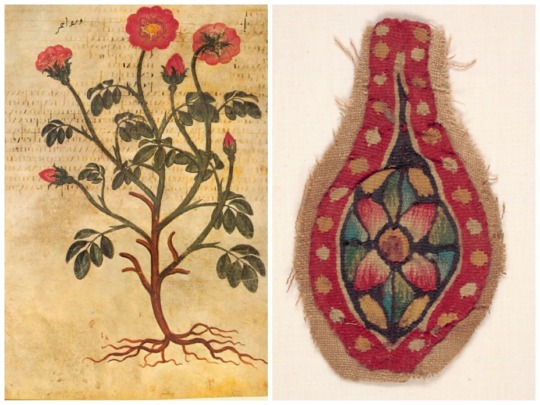
(Sol) Pedanius Dioscorides, Yunanlı Hekim’in “De Materia Medica” ya da “Vienna Dioscorides” adlı kitabından Rhodon-Rosa lutea (Gül) http://exhibits.hsl.virginia.edu/herbs/vienna-disocorides/
(Sağ) Bizans 5.6.yy’lara ait yün tunikten kalan alınmış süsleme,Mısır,goblen örgüsü
Masumiyetin ve Hz Meryem’in sembolü olarak bilinen zambaklar da Geoponika’ya göre güller gibi kuru yerde yetiştirilmesi önerilen çiçekler arasındadır. Kitapta, tıpkı gül gibi onun da doğada peyda olması mitolojik bir hikâye ile anlatılır. Hikâyeye göre Alkmene’nin Zeus’tan olma oğlu Herakles ölümlüdür. Zeus oğlunun ölümsüz olmasını ister ve bunun için Hera’dan onu emzirmesini rica eder, ama Hera’nın kıskançlığı minik yavruyu emzirmesine mani olur ve şiddetle Zeus’u reddeder. Zeus pes etmez ve Hera uyurken Zeus minik yavruyu Hera’nın kucağına bırakır. Daha sonra minik Herakles aç olduğu için Hera’nın göğsüne yapışarak öyle bir emer ki ağzından sütler fışkırır ve Hera’nın sütü bir türlü kesilmez. Ve sonunda dünya üzerine düşen bu süt damlacıkları yeryüzünde birer beyaz zambağa dönüşür. Geoponika bu hikâyedeki beyaz zambakların ve daha nice renklerdeki zambaklarınızın daha çok çiçek açmasını ve daha uzun dayanmasını istiyorsanız yapmanız gerekeni şu şekilde yazar: zambakların soğanlarından bazılarını on iki parmak derine, sonra sekiz parmak ve en son da dört parmak derine ekin ve böylece daha dayanıklı zambaklar elde edin.
Tabii ki en sona en sevdiğim çiçeği sakladım; yani nergisi. Kendisine deli gibi âşık olan Ekho’ya karşılık vermeyen, kendini beğenmiş, uyuz Narcissos’un hikâyesi ders alınacak mitolojik öyküler arasında bir numara diyebiliriz. Bu kendini bilmez genç adam zavallı Ekho’nun ahını aldığından mıdır yoksa “karma”dan mıdır bilinmez, bir gün dağlarda dolaşırken, ağaç ve yeşillikler içinde kaybolmuş bir pınara rastlar; eğilip su içmek istediğinde suda gördüğü hayale, yani kendisine âşık olur. Sevdiğine kavuşamamanın verdiği elemle sararıp solar ve ölür. Daha sonra periler Narcissos ’un cesedinin yerinde bir sapsarı bir çiçek bulurlar. Sararıp solan genç adam nergis çiçeği olarak öylece durur ırmağın kıyısında ve hikâyesi de günümüze kadar Geoponika sayesinde gelir.
Bu güzel çiçekler elbette bahçelerde yetiştirilmek dışında farklı alanlarda da kullanılıyordu Bizans İmparatorluğu’nda. Sunum konusunda bugünkü “yeni gelinleri” cebinden çıkaracak kadar şaşaaya ve gösterişe meraklı Bizanslı yöneticiler “diplomatik” amaçla gelen elçileri ve misafirleri etkileyebilmek için doğanın gücünü ve çiçeklerin sahip olduğu ortak dili kullanmışlardı. Örneğin Rus prensesi Olga, Tarsus ve Amida Emiri’nin sefirleri ve Cordaba’dan gelen sefirlerin tekmili birden VII. Konstantin Porfirogennetos’u ziyarete geldiklerinde, Bizans ahalisi anlı şanlı isimlerine yakışır bir zenginlikle, arkalarından laf edilmesin diye süsle ve zarafetle karşılamıştı yabancı misafirlerini. Avizeler, zincirler belli başlı kiliselerden saraya taşınmış, ünlü Bizans ipeğinden ve keten kumaşlardan dokunan zarif perdeler, örtüler, aslan ve griffin desenli pelerinler ile bezenmişti sarayın tüm salonları. Altından ve gümüşten tabaklar, taçlar, yataklar, masalar ile donatılan koskoca sarayda, misafirleri eğlendirmek için orglar bile hazırdı. Ve tabii mis kokulu çiçekler de unutulmamıştı. Gül taç yapraklarıyla süslenmişti Magnaura’nın Triklinos’u. Defne ve sarmaşıklarla donatılmıştı koridorların yerleri. Mevsimin çiçekleriyle taçlandırılmıştı koridorlardaki sütun başları. Mersinlerle donatılmıştı imparatorun odasının yerleri ve Chrysotriklinos mis gibi biberiye ve gül kokmuştu. Elçilerin elleri yemeklerden önce taze asma yaprakları ve gül suyu ile temizlenmişti ve ipek kumaşlarla kurulanmıştı. Böylece cennetten bir köşe sunmuştu VII. Konstantin Porfirogennetos misafirlerine, yıllarca anlatılsın dilden dile diye.
Kokularıyla ve renkleriyle Bizanslıları mest eden çiçekler, aynı zamanda Bizans İmparatorluğu’nda çaresiz dertlere de şifa olmaktaydı. Örneğin Ortaçağ’da tatlı olarak yapılan gül şekeri, gülün “soğuk kuru” olmasının etkisiyle baş ağrısına iyi geliyordu. Bunun dışında gül, mideyi de canlandırıyordu ve karaciğeri koruyordu. Menekşe ise nemli ve soğuk bir çiçek olarak uykusuzluk çekenlere şifa olmuştu. Aynı zamanda baş ağrılarını dindirirdi. Nilüfer ise soğuk nemli bir çiçek olarak tıpkı menekşe gibi sakinleştirip uyku getirme etkisine sahipti. Nergis soğuk olarak adlandırılırdı ve kökü kaynatılınca sağlam bir kusturucu olabilirdi. Akzambağın ise tıpkı papatya gibi dinlendirici sakinleştirici bir yanı vardı.
Antik Yunan-Roma kültürlerinden miras aldıkları ve Hristiyan kültürüyle harmanladıkları doğa sevgisini, bağ bahçe kültürünü ve çiçeklerin farklı aromalarını Bizanslılar elbette sofralarına da taşımışlardı. Şarabı sofralarından eksik etmeyen Bizanslılar çiçekleri hoş koku veren tatlar olarak şaraplarında da kullanarak damak zevklerini zenginleştirmişlerdi. İçine bolca bal koyup şeker hastalığına davetiye çıkaran Bizanslıların bu şarapları nasıl yaptıklarına dair günümüze ulaşan tariflerini ise elbette sizden saklayacak değilim; işte gelmek bilmeyen yaz için Bizans’ın içinizi ferahlatacak çiçek aromalı şarap tarifleri, Andrew Dalby’nin “Bizans’ın damak tadı” kitabında özetlendiği şekliyle:
-Menekşeli şarap: 3,5 litre bal, 10 litre şarap, 240 demet menekşe. Öncelikle çiçekleri nazikçe ayırıyoruz. Daha sonra 30 gün boyunca şaraba yatırıp sonra süzüp çiçekleri ayırıyoruz. Balı kaynatıyoruz, iki sıvıyı harmanla dikkatlice mühürleyip ve bir kenara koyup dinlenmesini bekliyoruz.
-Papatyalı şarap: 10 litre Ascalon şarabı (İsrail’de olan bir şarap), 3,5 litre bal, 200 gram yaban papatyası (şart değil illa yaban papatyası olması, park bahçelerdeki papatya da olur) tohumu. Tohumları 30 gün boyunca şaraba yatırıyoruz. Süzdükten sonra balı kaynatıp köpüğünü alıyoruz sıvıları harmanlıyoruz, mühürleyip bir kenara koyuyoruz.
-Güllü şarap: Kirli olmadığı zaman gül yapraklarını topluyoruz ve yıllanmış bir şarabın içine abartmadan gül yaprakları ekliyoruz. Her gün onları çömleğin dibine ininceye dek sivri bir kamışla karıştırıyoruz. Hava almayacak şekilde çömleği mühürleyip 30 gün dinlenmeye bırakıyoruz. Daha sonra şarabı süzüyoruz ve 2,5 litre şaraba dikkatlice harmanlayacak yarım litre olacak şekilde balı koyuyoruz. Otuz gün bekledikten sonra afiyetle içiyoruz.
* Achmet, 10.yy’da yazılan Ὀνειροκριτικά olarak bilinen rüyaların yorumlanması kitabının yazarıdır. Steven M. Oberhelman, Dreambooks in Byzantium: six Oneirocritica in translation, with commentary and introduction (Aldershot : Ashgate, 2008).

Sant'Apollinare Nuovo Bazilikası Mozaiği, Ravenna
Kaynakça:
Beihammer, Alexander Daniel, Stavroula Constantinou, and Maria G. Parani. Court Ceremonies and Rituals of Power in Byzantium and the Medieval World. Comparative Perspectives. Leiden ; Boston : Brill, 2013.
DF531 .C68 2013
Dalby, Andrew, Ali Özdamar, and Nazlı Pişkin. 2004. Bizans'ın damak tadı: kokular, şaraplar, yemekler. İstanbul: Kitap Yayınevi, 2004. TX725.B97 D3520 2004
Dalby, Andrew. 2011. Geoponika: farm work : a modern translation of the Roman and Byzantine farming handbook. Totnes: Prospect Books, 2011.
S429 .G413 2011
Littlewood, Antony Robert, Henry Maguire, and Joachim Wolschke-Bulmahn. Byzantine garden culture. Washington, D.C.: Dumbarton Oaks Research Library and Collection, 2002.
SB457.547 .B97 2002
Maguire, Henry. Byzantine court culture from 829 to 1204. Washington, D.C. : Dumbarton Oaks Research Library and Collection ; [Cambridge, Mass.] : Distributed by Harvard University Press, 1997. DF521 .B934 1997
Maguire, Henry. Nectar and illusion : nature in Byzantine art and literatüre. New York: Oxford University Press, 2012.
NX650.N38 M34 2012
Maguire, Henry. Rhetoric, nature and magic in Byzantine art. Aldershot; Brookfield, VT : Ashgate, 1998.
N7852.5 .M35 1998
McCabe, Anne Elena. A Byzantine encyclopaedia of horse medicine: the sources, compilation, and transmission of the Hippiatrica. Oxford: Oxford University Press, 2007.
SF951 .M477 2007
Oberhelman, Steven M. Dreambooks in Byzantium: six Oneirocritica in translation, with commentary and introduction. Aldershot: Ashgate,2008. BF1080 .O24 2008
0 notes
Text
Mom sings a lullaby for her sleeping babies

{Amida Olit Reint family }
🩵:〰️🎵🎶🎵
Only the line draft was drawn… Perspective may be a little strange…👀
#cuphead parents#cuphead#cuphead oc#vickers&eli#cuphead and mugman parents#Amida Olit Reint family#mugman#Eli Amida#Vickers Leant#baby cuphead
41 notes
·
View notes
Text

The moment when parents kiss!💗(?
22 notes
·
View notes
Text

Must show off!!!
It's cute!(´。✪ω✪。`)(σ′▽‵)′▽‵)σ

#cuphead parents#cuphead and mugman parents#cuphead#cuphead oc#vickers&eli#Eli Amida#Vickers Leant#art commission#commission
22 notes
·
View notes
Text
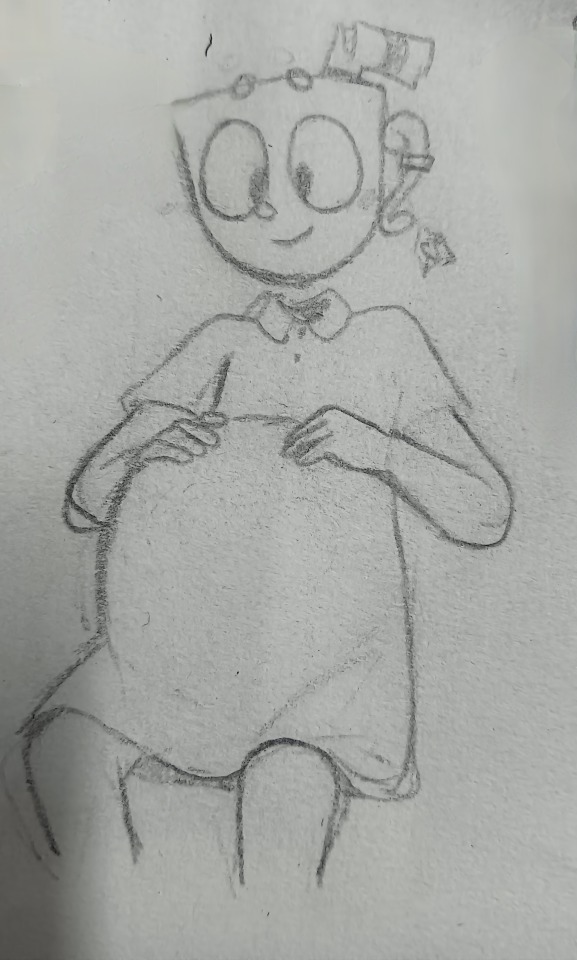
Eli during pregnancy(*˘︶˘*).。.:*♡
#cuphead parents#cuphead oc#cuphead#cuphead and mugman parents#sketch#Graffiti on paper#pregnancy#Eli Amida#amida olit reint family
14 notes
·
View notes
Note
How old are Eli and Vickers?
(In the past)
Eli: 13
Vickers:14
(I will announce the ages of other characters one by one when they appear.)
8 notes
·
View notes
Text

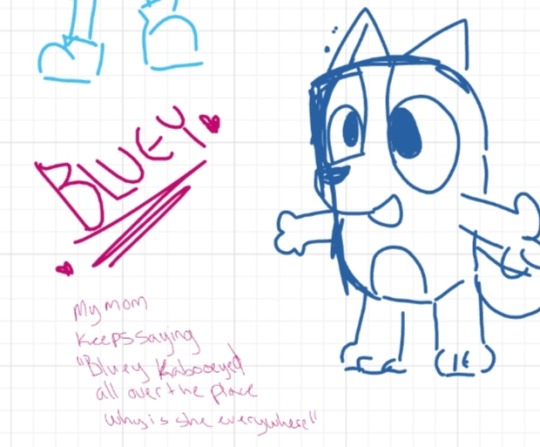


What I drew on the whiteboard earlier
Also drew Chai(・∀・) @whosectype
Although these are already half a month ago painted things...
7 notes
·
View notes
Text

Emmm , this is a small interaction I drew before between two cupheadmothers from different AUs.(^-^)/
Madammug belongs to:@inkwell-bloodline
They are very cute(*˘︶˘*).。.:*♡
(The manga is being prepared……
14 notes
·
View notes
Note
I love Eli, I will lowkey marry them, (Patonically)
Also, I'm terribly sorry I don't know their gender. I wasn't paying attention to that, and i'm sorry!
It's okay, you don't need to apologize. Actually, initially I wanted to give Eli a more neutral appearance design, but she is indeed a girl. Thank you too for liking them(^_^)
(。・ω・。)ノ♡

6 notes
·
View notes